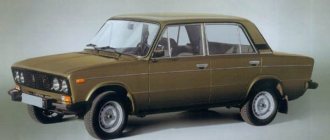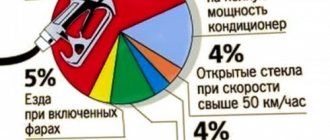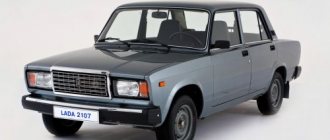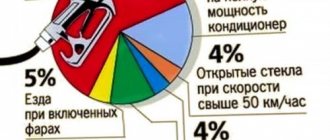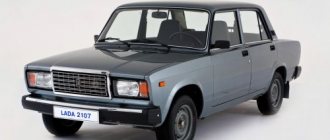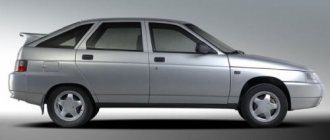10-14 6-9 VAZ
admin 01/12/2017
- Fuel consumption VAZ 2106 1.3l. Real fuel consumption of VAZ 2106 1.3l.
- Real fuel consumption of VAZ 2106 1.5l.
- Real fuel consumption of VAZ 2106 1.6l.
VAZ 2106 is a four-door rear-wheel drive car with a sedan body type. Car production started back in 1976 at the Volzhsky Automobile Plant. Further, the construction of cars was carried out at factories in Syzran and Kherson. Until the model was removed from the assembly line, he was engaged in the creation of Zhiguli in Izhevsk. Production of the VAZ 2106 was stopped on December 28, 2006.
Fuel consumption VAZ 2106 1.3l.
The VAZ 2106 was equipped with a five-speed gearbox and a gasoline carburetor engine with a displacement of 1300 cc. and power 64 hp. The car has a top speed of 145 km/h and accelerates from zero to hundreds in 18 minutes. Fuel consumption within the city is 9.5 liters, and on the highway – 7.6-8 liters per hundred kilometers.
Real fuel consumption of VAZ 2106 1.3l.
- Andrey. Kirov. I inherited a VAZ 2106 produced in 1992 from my father. This was five years ago. Of course, at that time there were practically no “original” spare parts in the car, but the engine worked “like a clock” and never let me down. If you don’t press the gas pedal to the floor on the highway and warm up the car thoroughly in winter, then there will be no problems with it. I think that a domestically assembled engine, with proper and timely maintenance, will last for many more decades. As for fuel consumption, my 1.3 liter engine “eats” about ten liters in the city, and on the highway – within seven liters per hundred.
- Oleg. Tomsk I bought a VAZ 2106 from a neighbor in 2005 with a 1.3-liter engine. The car came off the assembly line back in 1988, so you understand that its condition was not the best. I overhauled the engine, replaced all consumables, slightly modernized the interior and drove it without problems for five years. I was also completely satisfied with fuel consumption: in the city no more than ten liters, and on the highway during normal driving it was possible to keep within 7.5-8 liters.
- Sergey. Adler. I bought a VAZ 2106 from 1985 specifically for taxi work. The previous owner loved his car, so I got it in very good condition. I drove the “Six” for almost seven years and during this time it did not create any special problems for me. If we talk about fuel consumption, then I got about ten liters in the city and eight on the highway.
- Vladimir. Kazan. The VAZ 2106 with a 1.3-liter engine is a good domestic car that, with proper care, can faithfully serve for several decades. I bought my ’85 “six” in 2001 in order to take my family to the dacha and visit relatives. In addition, I also drove the car for work, so it rarely came into my garage. During the entire period of operation, I never looked into the engine, since there was no need for this, it worked properly and did not let me down. In terms of fuel consumption: in the city with normal traffic it was up to ten liters, and on the highway - 8-8.5 liters per hundred.
- Alexei. Ulyanovsk VAZ 2106 1.3 liter - this is my first car. I bought it new off the production line in 2001 and drove it for almost ten years. Of course, immediately after the purchase I had to tighten up a few things and blow out the bottom, but otherwise I had no complaints about the car. The machine is a real “workhorse”; I have no doubts about this during the entire time I used it. In terms of consumption, I can say the following: in the city I got from eight to ten liters, and on the highway (if I didn’t press the accelerator pedal to the floor) - 8-8.5 liters per hundred kilometers.
VAZ 21011
“Zero Eleven” or “Zhiguli-1300” is a modified model of the base VAZ 2101. The changes affected only the appearance (the radiator grille received more vertical bars, “fangs” disappeared from the bumpers and rubber pads appeared, brake lights received reflectors). The VAZ 21011 was equipped exclusively with a 1.3-liter engine with a power rating of 69 hp.
| Engine | Consumption (city) | Consumption (highway) | Flow (mixed) | Type of fuel |
| 1.3 MT 69 hp | 9.4 | 6.8 | 8.0 | Petrol |
Fuel consumption VAZ 2106 1.5l.
VAZ 2106 1.5. It was equipped with a gasoline carburetor engine and a five-speed manual transmission. The engine displacement is 1452 cc and power is 72 hp. Engine torque is 104 Nm at 3400 rpm. The car has a top speed of 150 km/h and accelerates from zero to hundreds in 17 seconds. Fuel consumption VAZ 2106 1.5l. in the city it is 9.8 liters, on the highway - 7.4 liters per hundred kilometers.
Other cars: Kia Karens fuel consumption reviews
Real fuel consumption of VAZ 2106 1.5l.
- Vladislav. Samara. Six years ago I bought a second-hand “six” with a one and a half liter engine for work and I drive it to this day. What can I say, in my opinion, this is the best car for our roads. In addition, considering that the car rolled off the assembly line back in 1988, its condition can be said to be ideal. If your head “cooks” and your hands grow from the right place, then you can use the “six” for more than a dozen years. In terms of gasoline consumption, my average is ten liters in the city and up to 8.5 on the highway.
- Dmitriy. Kazan. My “swallow”, after a major overhaul in 2001, still doesn’t drive, but flies! I completely overhauled the engine and gearbox, changed all the consumables and slightly modernized the interior. Since then there have been no major problems. In terms of gasoline consumption, I get about ten liters when driving around the city and no more than nine on the highway.
- Egor. Samara. I inherited my “six” with a one and a half liter engine from my father in 1995. My father loved the car very much and looked after it carefully. The machine served me faithfully for ten years, after which I sold it. It seems to me that for our expensive VAZ 2106 it is exactly what we need. The machine is stable, durable, convenient, and most importantly, not expensive to maintain. In terms of gasoline consumption, I got no more than 10 liters in the city (in normal traffic) and up to nine liters on the highway.
- Ivan. Saint Petersburg. I bought the car off the production line in 1993. Of course, for greater comfort and safety I had to tighten some parts and blow out the bottom, but otherwise I was completely satisfied with the car. Playful, easy to control and stable. In addition, the suspension is not very stiff, and the interior is spacious and comfortable. I sold my “six” five years ago and today I already regret it. The car “eats” relatively little, and maintenance costs pennies. My gasoline consumption averaged up to 10 liters within the city and 7.5-8 liters on the highway, which I think is quite normal.
- Victor. Kostroma. I bought a used 1993 Six from a work colleague. What can I say, the car is a real classic of the domestic automobile industry. A spirited engine, a relatively soft suspension, a comfortable interior that warms up quickly in winter. In addition, if the hands grow from the right place, then maintenance costs mere pennies. Fuel consumption is also within normal limits: in the city up to ten liters, and on the highway (if you don’t drive) you can keep within 7.5-8 liters per hundred kilometers.
- Nikita. Moscow. I bought a “six” second hand after a major overhaul. At that time, it already had 7,000 kilometers on it. Today the mileage is 25,000 km, and I still have no complaints about the machine. It picks up speed quickly, has good stability and controllability, and most importantly, is inexpensive to maintain. In terms of gasoline consumption, everything also suits me: in the city with heavy traffic it turns out to be up to ten liters, and on the highway with normal driving you can keep within 8 liters.
- Victor. Stavropol. It seems to me that the “six” with a one and a half liter engine is an ideal car for those who are just acquiring driving skills and are trying to figure out how everything works in the engine, gearbox, etc. The car is easy to control, stable and playful. I’ve been riding mine for five years now and I don’t have any particular complaints, although I bought it used. Gasoline consumption is also within normal limits: in the city I get no more than ten liters, and on the highway, if I don’t drive, it’s 7.5-8 liters.
- Natalia. Belgorod. My husband bought a VAZ 2106 from 1988 from a friend. He said that this is an ideal option for acquiring driving skills. And today I understand that he spoke the truth. We made a capital investment immediately after the purchase, and to this day we have no complaints about the machine. Of course, this is not a foreign car with climate control and leather seats, but the car is quite enough for everyday movement around the city. In terms of gasoline, I get about ten liters in the city and 8-8.5 on the highway.
Other cars: Ford Scorpio fuel consumption owner reviews
Fuel consumption VAZ 2106 1.6
VAZ 2106 1.6. with a manual five-speed gearbox, equipped with a gasoline carburetor engine with a working volume of 1569 cc and a power of 75 hp. Maximum torque Nm at rpm – 116/3000. The maximum speed of the car is 155 km/h. acceleration from zero to hundreds is carried out in 16 seconds. Fuel consumption: city - 10.3 liters, highway - 7.4 liters per hundred kilometers.
Real fuel consumption of VAZ 2106 1.6l.
- Sergey. VAZ 2106 produced in 1976 is my first car. What can I say, the car is not bad, but it came to me in terrible condition. I made a capital investment, after which I rode it for another seven years. During this time there were no special complaints. If breakdowns did occur, in most cases they were able to be fixed independently with minimal investment. In terms of consumption after repair, it turned out exactly as stated in the passport - no more than 7.5 liters on the highway and a little more than ten in the city.
- Eugene. Astrakhan. I bought a six with a 1.6-liter engine from a neighbor a couple of years ago. The previous owner's car sat in the garage for a long time, so I had to tinker with it. Despite the fact that the car came off the assembly line back in 1984, it is in good condition. Now I also want to repaint the body and install new seats for greater comfort, and I can still ride for at least a hundred years!))) In terms of gasoline consumption, I can say the following: in the city 10-11 liters, on the highway no more than 8.5 liters per hundred.
- Valery. Kostroma. I recently bought a six with a 1.6 engine from a friend. I can only say one thing: you shouldn’t buy such a car after driving a foreign car for several years. On my first trip I almost went crazy! At a speed of 70-80 km/h, everything in the cabin begins to creak and rattle, and when accelerating to 120, it throws the car from side to side. Of course, taking into account the age of the car (1979), you can make a discount, but still... In terms of fuel consumption, of course, everything is more than good: in the city - a little more than ten liters, and on the highway during normal driving you can keep within 8 liters.
- Nikolai. Kaluga. My father gave me a VAZ 2106. This was my first car, which I could not get enough of. I rode an “old lady” made in 1979 for almost seven years and I can say with confidence that this is an ideal vehicle for those who want not only to gain driving skills, but also to understand what and how it works in a car. For gasoline, I got no more than ten liters in the combined cycle.
- Marina. Kazan. My husband gave me a VAZ 2106 from 2000. What can I say: the car is excellent, easy to control and playful. In addition, even the most complex repairs are not expensive, which is also nice. My gasoline consumption is as accurate as it is stated in my passport: 7.4 liters on the highway and 10.3 in the city.
- Denis. Krasnodar. I took a VAZ 2106 produced in 1999 for work. I do repairs and constantly travel to customers, both around the city and beyond. The car suits me perfectly. It is easy to control, stable, with a relatively soft suspension. In addition, even when I load the roof rack with building materials, the speed also develops quite quickly and it pulls well downhill. In terms of gasoline consumption: in the city with normal traffic it turns out to be 10-11 liters, and on the highway, if you don’t drive, you can keep within 7.5-8 liters.
- Oleg. Khabarovsk. The main advantage of the VAZ 2106, as for me, is the ease of repair and maintenance. If the hands grow from the right place, then repairs generally cost pennies. I’ve been driving my “six” for ten years now and I have no complaints about this “workhorse”. Fuel consumption also suits me: in the city I spend a little more than ten liters, and on the highway I get within eight.
- Peter. Rostov-on-Don. My “six” served me faithfully for fifteen years. This car was created for our roads and there can be no doubt about it. Over the entire period of operation, I, of course, replaced the bulk of the “original” spare parts and once made a major overhaul of the engine. But even so, maintenance over the entire fifteen years cost me mere pennies. As for fuel consumption, my “swallow” “ate” about 10.-11 liters in the city and up to eight on the highway.
- Maksim. Chelyabinsk. My father bought a VAZ 2106 2000 from the factory. Of course, I immediately had to go to the service station to tighten the bolts where necessary and blow out the bottom. Otherwise, my father was completely satisfied with the car and drove it for ten years, after which he gave it to me. I want to say this: if you take care of the car, carry out repairs and maintenance on time and drive carefully, then the VAZ 2106 will last at least a hundred years. In terms of gasoline, even today I get it practically, as it is written in my passport: 10.5 -11 liters in the city and 7.5-8.5 on the highway.
- Konstantin. Vladimir. I bought a VAZ 2106 with a 1.6-liter engine to work in a taxi service. I am completely satisfied with the car. The engine works properly, even in severe frosts the car starts with half a turn, repairs and maintenance are not expensive, and gasoline consumption does not exceed the figures specified in the documents: 10.5 liters in the city and 7.5 liters when driving on the highway.
Other cars: Gili Emgrand x7 fuel consumption reviews
We reduce gasoline consumption on VAZ cars
When discussing how to reduce fuel consumption on the VAZ 2106, 2107, 2109, 2114, 2101, Lada Granta, Kalina, Priora and other models of the domestic automobile industry, motorists name the three main areas for saving gasoline:
- driving style and speed,
- aerodynamic factors (roof rack, open windows, air cushion),
- technical settings of the mechanism and selection of consumables.
The content of the article
Driving style as a way to reduce fuel consumption on VAZs
For VAZ models, the optimal economy mode is driving at a speed of 90 km/h on a flat road, and in the city - with smooth (not slow, but “smooth”) acceleration and braking. Driving at 120 km/h adds an average of 1-2 liters per 100 km to your consumption. Driving around the city adds another 50-80% of consumption compared to the optimal speed limit on the highway.
Specific fuel consumption is affected by load and crankshaft speed. Previously, carburetor VAZ cars were configured so that when the gas pedal was depressed at 80%, the economizer was activated. It enriched the mixture by 20%, and the specific consumption increased by 10%, which, without burning, flew out into the exhaust pipe. With this setting, the most noticeable economic effect occurred at the threshold of turning on the economizer (at 75% load).
In carburetors VAZ 2105, 2106, 2107 and others released later, the question of how to reduce fuel consumption was solved by simply changing the settings and connecting another carburetor chamber. With its smooth entry into operation, the enrichment of the mixture also occurred gradually and became maximum when the throttle valves were opened “to the fullest.”
So, due to a slight reduction in power, efficiency increased with a shift in optimal savings towards loads with a higher value.
Injection engines with modern fuel injection systems and mixture enrichment catalysts have further shifted the optimal amount of savings towards increasing load. Therefore, for example, when advising how to reduce fuel consumption on a VAZ 2107 injector, experts talk about the advisability of squeezing about 90% if ideal driving conditions are considered. Under such conditions, pushing the pedal “to the floor” increases consumption by 5%, and this is still more economical than half-pressing the pedal.
Fuel consumption of VAZ 2106 with gas equipment
- Vlad. Ekaterinburg. I have a VAZ 2106 1.5 on gas. I had already come across gas equipment for cars before, so I installed it myself at minimal cost. I am completely satisfied with the car both in operation and maintenance. After switching to gas, fuel costs decreased several times, which I am very pleased with. I get about 8.5 liters on the highway and 10-11 when driving around the city.
- Semyon. Pskov. I bought a VAZ 2106 1.3 to work in a taxi service. Despite the fact that the car is over twenty years old, it drives normally, and serious breakdowns are extremely rare. I recently switched to gas and my fuel costs immediately dropped noticeably. During normal driving on the highway I get 8-9 liters, and within the city – 10.5-11 liters per hundred kilometers.
- Alexander. Nizhny Novgorod. I bought a “six” with a one and a half liter engine from a friend and immediately decided to install gas equipment on it. Of course, during the entire period of operation (8 years), I replaced almost all the “original” spare parts, and also repainted the body. There are no special complaints about the car. The car is maneuverable, playful and durable. In terms of gas consumption, I get about 10-11 liters in the city and no more than 8.5 when driving on the highway.
- Stas. Peter. I inherited the “Six” from my grandfather. Grandfather had not driven his car for more than three years, so he had to go through almost everything in it and also repaint the body. To save more fuel, I bought a gas installation, which the guys at the service station installed in just a few minutes. I can say this: if you take care of the car, change consumables and oil on time, then it will “run” for more than one thousand kilometers without serious breakdowns. Today my consumption is no more than 11 liters in mixed mode.
- Basil. Lipetsk. I provide plumbing services, so I simply cannot do without a car. I was looking for a cheap car with low fuel consumption and a friend advised me to buy a VAZ 2106 with a gas installation. I bought a car in excellent condition, right after a major overhaul. I’ve been riding for four years now and have no complaints about my “old lady”. I replace consumables and minor repairs myself, so the cost of maintaining the car is minimal. My gas consumption is low: up to nine liters on the highway and no more than 11 liters in the city.
- Kirill. Ufa. I bought a “six” with a one and a half liter gas engine and in five years I have not regretted it even once. The machine is simply a “workhorse”! I constantly go on long-distance business trips and don’t worry about getting seriously damaged on the highway. If you take care of the car and use it carefully, it will faithfully serve for many decades and will “outlast” most modern foreign cars. With a gas installation, my consumption is within 11 liters in the city and 8-9 on the highway.
Technical component
As for the technical condition, increased consumption can be caused by the power plant itself, transmission, or chassis. Now about each of them in detail.
Cylinder-piston group
If the engine has almost completely exhausted its resource, then you should not expect economical consumption of gasoline from it. Severe wear of the cylinder-piston leads to the fact that the gaps between the cylinder walls and rings increase. As a result, both exhaust gases and the air-fuel mixture penetrate into the sub-piston space in large quantities.
Due to wear due to the same gaps, compression in the cylinders drops, so the conditions for normal combustion in the cylinders are not met. In this case, the air-fuel mixture does not burn fully, and part of it simply flies out into the exhaust pipe.
Wear affects the power performance of the motor itself - they decrease. The car's dynamic and speed performance decreases. Therefore, in order to accelerate the car and maintain speed, the driver has to press the gas pedal harder.
Therefore, if you need fuel economy on a VAZ-2106, first of all you should diagnose the engine - measure the compression, listen to the engine operation for the presence of third-party noise. If the resource of the power plant is almost exhausted, then a major overhaul should be carried out with the replacement of worn-out components.
The gas distribution mechanism also plays an important role. If a layer of carbon has formed on the valve seats and edges, this will lead to the fact that they will not be able to fit tightly, and this will result in a loss of compression. All this can be “treated” by repairing the cylinder head and grinding in the valves.
Violation of valve timing also affects consumption. And these phases are affected by the degree of wear of the elements of the gas distribution mechanism (camshaft, valves, rockers, drive chain), as well as the thermal gap. Therefore, when trying to reduce fuel consumption on a VAZ-2106, you should also pay attention to the timing belt - replace heavily worn elements, correctly adjust the thermal gap, which will ensure that the engine follows the valve timing.
Supply system
Let's go through the systems. Naturally, one of the biggest influences on consumption is the power supply system and its main element – the carburetor. If it is heavily clogged, and even incorrectly adjusted, then the fuel dosage is disrupted. Therefore, you should definitely check the condition of this element and wash it periodically.
The air filter also affects consumption. If it is heavily clogged, then its throughput drops significantly, resulting in a lack of air and an enriched fuel mixture enters the cylinders. Therefore, it is imperative to change the filter element on time.
Now about the adjustment work with the carburetor. Correct flow adjustment is important here. The fact is that by installing jets with a reduced cross-section and certain settings of quality and quantity screws, you can achieve a significant reduction in consumption. But at the same time, the power and dynamics of the car also drop. That is, it is almost impossible to accelerate the car, and you can forget about overtaking. But you can adjust the carburetor in the opposite direction - the engine will “tear”, but its “appetites” will increase greatly.
This is where you need to adjust the carburetor so as to achieve the optimal middle ground between consumption and power. In this case, no jets need to be changed.
Ignition system
Now about the ignition system, since it also affects consumption. Heavily clogged spark plugs that have almost exhausted their service life and work intermittently, incorrectly installed ignition on the engine, losses due to breakdowns of high-voltage wires and tips - all this can have a significant impact on consumption.
Therefore, you should definitely check the condition of the spark plugs and replace them if necessary. The ignition must also be installed correctly. You can replace the standard distributor with a contactless one, which will reduce voltage losses and also facilitate maintenance and ignition adjustment.
All damaged wiring should be replaced (it’s not difficult to check it - just start the engine in the dark and open the hood. If any wires break through to ground, it will be very clearly visible).
The lubrication system also affects consumption, or more precisely, the lubricant. To reduce friction between engine components, you should use high-quality synthetic oil, which will further facilitate starting the engine in the winter season.
Transmission
Let's move on to the transmission. First of all, here you should check the condition of all component parts, repair and adjust if necessary. It is also necessary to promptly change technical fluids in the gearbox and rear axle to reduce friction and reduce the load on the engine.
If the VAZ-2106 is equipped with a 4-speed gearbox, then it can be replaced with a 5-speed one. In urban conditions, this will not give any savings, since 5th gear in the city, in fact, is not particularly needed. But on the highway, when 5th speed is used, the consumption decreases, and noticeably.
Chassis
Next is the chassis. Worn or over-tightened wheel bearings will create high rolling resistance. To remove it as much as possible, you need to service the hubs and adjust the tightness of the bearings.
Misregulated camber and toe angles give the same result as overtightened bearings. Therefore, it is imperative to set these angles correctly.
Worn steering components cause the wheels to oscillate when driving, which increases drag. Adjusting the controls eliminates all of this.
Tire pressure should be constantly monitored. If it is reduced, then the contact patch of the wheel with the road is increased, and this is additional rolling resistance.
You should also use season-appropriate tires. This is especially true when people continue to drive on winter tires in the summer. The peculiarity of these tires is that they use softer rubber, which will create resistance.
The body, or rather the attachments, also affects consumption. Tuning elements (bumpers, body kits, etc.), as well as roof racks, greatly affect the aerodynamic performance of the car, which in the VAZ-2106 is not at its best anyway.
Due to the disruption of aerodynamics, the vehicle's resistance to oncoming air flow increases. If you remove all the attachments (make the car stock), you will be able to reduce consumption.
